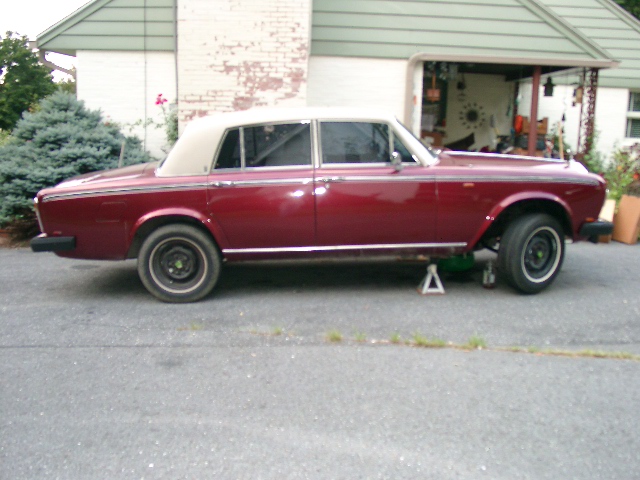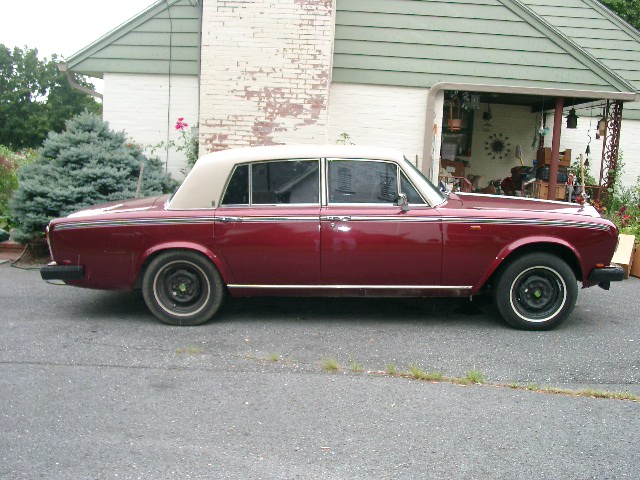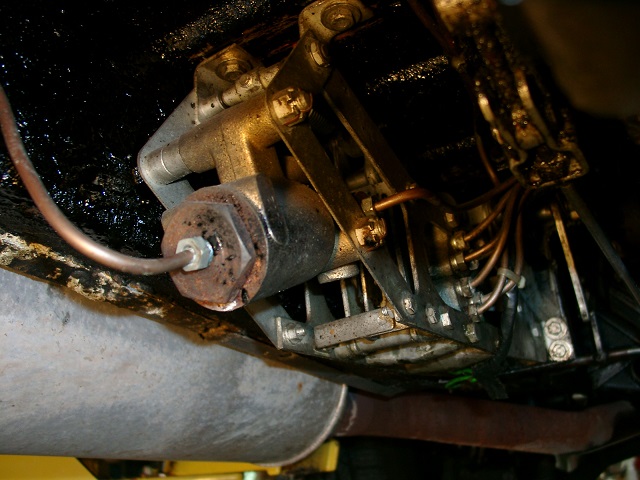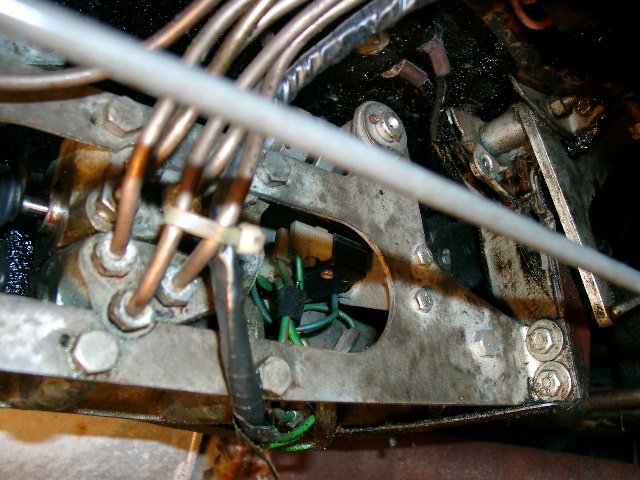| Author | Message | ||
Brian Vogel Grand Master Username: guyslp Post Number: 547 Registered: 6-2009 |
I know that I'm missing something, and am now frustrated beyond clear thinking, so am seeking further assistance. First, a picture of the car as she sits:  Background, in case it might help. The rear end, obviously, does not sit this high normally. When I put the front end up on jack stands, pushing the rear way down, and then later start the car with the driver's door open I get height control on steroids. The rear end pops up into the air and stays that way until the front goes down again. The car has been sitting this way throughout the "accumulator assembly surgery." Although I have no leaks of any kind from the reinstalled left side ACV or accumulator, I'm having several "weirdnesses" that I can't figure out. Prior to the great leak, the accumulator was (and, I still suspect, is) fully charged and I could get over 50 pumps when doing the brake pedal test. Now, I can't even get 10. Even with the above, when I bled the rear caliper on the left front wheel I had plenty of pressure and it quickly ran clear. I decided to bleed the pressure switch, too, and that had quite a bit more foam involved, but plenty of pressure, too. I did the switch twice, and the second time it was immediately clear and without any bubbles/foam. However, when I go to bleed the rear caliper on the right front wheel I have essentially no pressure, I don't even get what could be described as a trickle. If the car sits for 10 to 15 minutes the "Pressure Two" light comes on, but without any appreciable change in level in the reservoir. There might be a tiny change, but not much. If I intentionally depressurize the system it takes at least 30 pumps before the "Pressure One" light comes on and the level in the system one side of the reservoir shoots to above the full mark. I guess I could have a sudden leak of the nitrogen from the system two accumulator, but this really strikes me as unlikely. I also have no leaks of fluid under the car anywhere I can see. Can anyone offer possible explanations of the symptoms I've seen so far in light of the available information? If it's only possible from an exhausted accumulator then I guess it's time to rip things out, again. I'm at a loss and not able to think this through clearly. Brian | ||
Geoff Wootton Prolific User Username: dounraey Post Number: 272 Registered: 5-2012 |
Brian Since you are getting good pressure from the left hand rear caliper this must mean that the pump is ok. If you are bleeding this caliper without the engine running, then the accumulator must be ok also. I can only think that there is a blockage on the hydraulic pipe that runs to the right rear caliper, probably holding a lot of trapped air which would explain the rapid loss of pressure on the brake pedal test. The car looks great - I really like the color scheme. Geoff. | ||
Geoff Wootton Prolific User Username: dounraey Post Number: 273 Registered: 5-2012 |
Brian Since you are only one caliper down, my other thought is take it for a careful drive. This may relocate any airlocks. Then try bleeding again. Only you can assess whether this would be safe to do so but from the text it sounds that this would be ok. Geoff | ||
Brian Vogel Grand Master Username: guyslp Post Number: 548 Registered: 6-2009 |
Geoff, Since I have a fully functioning System One and a "nearly fully functioning while running" System Two I am thinking along the same lines you are. Just one small note, I have only dealt with the rear calipers on the front wheels so far. That's where I threw up my hands and said I need to walk away for the day. I still have to bleed the lower cylinder on each rear wheel caliper before considering making her mobile again, even for further testing. Brian, who, when the car was first purchased, was unknowingly driving on a single brake system since one of the warning lights had been conveniently disabled (and knew something felt wrong almost immediately) | ||
Brian Vogel Grand Master Username: guyslp Post Number: 554 Registered: 6-2009 |
Just another photo and documentary note. This is the car after the front tire has been replaced and then lowered to the ground. No doors have been opened, the engine not started, and the car has not moved. However, the "height control on steroids" disappears immediately. It does not return if I simply jack the car up, I must run the engine again but once I do, the boot lofts skyward and remains aloft until lowered to the ground.  The front end always settles back to its usual height once she's been moved. Brian | ||
Bill Coburn Moderator Username: bill_coburn Post Number: 1515 Registered: 4-2003 |
A few thoughts on your problem Brian. The blockage of flow to a caliper seems impossible given the 2500 psi force coming down from the distribution valves. But it happens. The most common is the complete disintegration of the rubbers in the deacceleration valve and for these bits to get down some part of the circuit and block it. There is no way you can free this. You simply remove the blocked section and get your local friendly brake man to make up a new one.. To find the location of the blockage. Start at the rat trap and undo connections on the way to the caliper until you get no or reduced feed. My next thought would be the flexible hoses in the system. In a perfect garage these have a life of 8 years but I have found specimens that immediately attracted the dinosaur chasers' attention. They seldom burst although with the mineral oil kit they have been known to blow off their mounting nipples. But the good old brake fluid ones disintegrate internally and a bit of the lining becomes a flap and aided by other bits and pieces becomes a very solid plug. Finally, the self leveling system does have a little known foible. When the high speed leveling mode is engaged it pumps up the rear end until it reaches the desired height as adjusted on the leveling valve. So if you get two broard beam passengers in the back seat the system on high speed leveling lifts the car to a nice height. When the waving and the blowing kisses routine is over and the car stops for the wavers to alight The driver (read chauffeur) switches off the engine having rammed the selector into ‘Park’ and leaps out to assist his passengers. The system of course is at slow leveling so the pressure in the rams on top of the rear springs remains the same and the rams stay extended so with the two passengers alighted, the springs reume their ‘relaxed’ state and the car elevates, assuming the posture of a constipated praying mantis! The trick which I have pointed out to some snotty chauffeurs is to leave the ignition on during the alighting! Very lastly remember when you place jack stands under the ‘A’ pillar the weight of the engine and transmission is also going to give you a rear end erection (so to speak). | ||
Brian Vogel Grand Master Username: guyslp Post Number: 558 Registered: 6-2009 |
Bill, Thanks for your input. I took the car out for a 30-mile drive this evening and everything seems to be performing pretty much as it should. I believe I do still have some air in the system 2 brakes, and will try bleeding them again tomorrow. If I do not have fluid flow at several calipers and/or pistons, I shall follow your advice. At least if a new segment of "hard" line were to be required I am equipped to fabricate same. I had to do this for a segment from the 4-way connector behind the left front wheel arch to the line that runs across the firewall to the "distribution block from hell" on the right side that's almost impossible to access. I was forever grateful that I could fabricate only a small splice line and figured out how to flare the existing mild steel line in place so that I didn't have to access that distribution block. The flexible hoses in my system, all of them with the exception of the high pressure hoses from the ACV, were replaced by me in 2009. I hope that I don't have an issue with those. What was interesting earlier today, before the test drive, was that I couldn't get much fluid to bleed from the right rear lower piston, either. My left rear lower piston has been "unbleedable" for several years due to the actions of a previous custodian that I have not prioritized to undoing. I will be curious to see whether the system 2 accumulator holds its pressure overnight or longer. The system 1 accumulator holds its pressure for many days, and the system 2 also did but for fewer than system 1 prior to this latest go-round. During the immediate post-reinstall period, but prior to the car having come back to earth, it wasn't holding its pressure at all, which mystified me. I really don't think it's an exhausted accumulator, but if this keeps up I'll finally be building a pressure gauge, which I have most of the parts for, and checking this out for certain. Brian, who will probably dance a jig after I sell SRH33576 and have only one SY car to tend to (but who will not sell until I'm convinced no brake issues exist) | ||
Martin Taylor New User Username: martin_taylor Post Number: 6 Registered: 7-2013 |
Bill, if the levelling system is wired correctly it will always be on fast mode when a door is open, a great way of flattening a battery when you leave a door open. Brian, It is not uncommon for the distribution valves to cease, check these a both moving with roughly the same resistance. | ||
Bill Coburn Moderator Username: bill_coburn Post Number: 1516 Registered: 4-2003 |
Martin/ Thanks for that. The levelling systems on those cars confused me many times for a variety of reasons. I frankly can't remember the detail but there was according to 'professional' advice some variation in how the solenoid was wired and what action triggered it. The whole area was prey to the leaking problem that was solved by popping a ball bearing in the main supply line under the floor. This was usually apparent if you remembered to look in that the screwed nipple union showed 'more threads' than usual. I am forever grateful I did not take maintenance of these cars on as a profession. The cars are a big enough challenge without carping whining owners whose passion for the cars exceeds the size of their wallet. But then we have this forum at which I have attended many years and I thoroughly enjoy the brain twisters so many of you pose both for the rest of us and for yourselves. Great age brings about Alzheimers and dementia but the mental gymnastics we have to go through plus regularly solving cross words should have us chanting part numbers with our dying breath?? Thanks to all of you, the web master who is omnipresent and David Gore for monitoring a site of temperance and good humour! | ||
Brian Vogel Grand Master Username: guyslp Post Number: 564 Registered: 6-2009 |
Martin, When you say "distribution valves" would you please refresh my memory as to where these are located, both physically on the car and in the parts and/or workshop manuals? I know I knew this once, but it's just not popping back in at the moment. I had wondered how I was getting the height control kicking in without the car running, but it sounds like the electrical circuits are one of the "always live" setups on these cars and if the battery is not isolated, and you have pressure in the accumulators, the car is going to elevate itself if it thinks it needs to. I thought all this was in an "off" state if the car was not running, but apparently not. Thanks, Brian | ||
Martin Taylor New User Username: martin_taylor Post Number: 7 Registered: 7-2013 |
The wiring for the levelling system has a few changes over time but the basic operation is the same, if a door is open with or without the car running the solenoid will be activated for fast levelling, When the engine is running the solenoid will be activated when in park or neutral. This is not perfect, if a large load is removed from the boot the rear can remain elevated until a door is opened, conversely if a load is placed in the car without the engine running the nitrogen pressure may not be enough to lift the car until the engine is started. Fixing cars via the Internet is a good challenge and just as satisfying as working on your own without the mess and fatigue that goes with working on your own toys  The "distribution valves" are in the rat trap under the floor, in a shadow there is a system of levers that pushes weight onto the rear brake master cylinder for feel, this linkage than has a balancing lever that puts an equal amount of force on both the distribution valves to allow high pressure fluid to the rest of the brakes. If one is ceased it will simply not move but the pedal will feel the same, also if the system pressures are different the easiest one will operate first. For all brake problems start at the beginning and check that both pumps and warning lights are working, check for pressure at the accumulators and work your way through the twin systems comparing results between the two systems. As Bill stated your problem is most likely a collapsed hose if there is a difference between the calipers on the same circuit (unless a pipe has been crushed). | ||
Brian Vogel Grand Master Username: guyslp Post Number: 565 Registered: 6-2009 |
Martin, Thanks. Since my car is an SY-II it doesn't have a master cylinder. To complicate matters, SRH33576 was converted from RHD to LHD at some point in her life, resulting in some "interesting" hydraulic pipework under the floor. Here are a couple of photos of the rat trap uncovered during my hose replacement marathon in 2009:     At least now that I have the starter issue resolved and I can move the car I can probably call upon my friend who has a lift to make all this checking a bit easier. Brian, who also wishes to express his gratitude to those who made it possible to post 480x640 pixel images in portrait orientation! |